5.28 Maytas LLWR Release Notes
Note regarding submissions
We would like to remind providers to create a submission early and check for any errors using reports from LLWR-Inform. Providers should also remember to download their ULI file. After submission to the DfE, providers should check that data has submitted correctly using the available reports. Providers should check that all their expected starts and completions are submitted correctly.
Our support desk gets extremely busy in the days prior to the submission deadlines, and although we try and prioritise submission-related queries, we cannot guarantee assistance if queries are sent late. If you do encounter any issues, please ensure that you contact Maytas Support as soon as possible, as we can only rectify issues of which we are aware. We also recommend checking Maytas Communities regularly for information on any known issues and solutions. Tribal cannot be held responsible for any issues caused by your failure to comply with this advice
Technical specification
The latest Maytas and Maytas Hub technical specification can be found here.
Once the upgrade has been completed, the version number should be checked to ensure it has been successful.
- Start Maytas and go to Support on the toolbar.
- Click About.
- The version numbers should read 5.28.9010.1. If you have any other version, please ensure you have followed the upgrade instructions correctly. If you require assistance, please contact Maytas Support.
It is the responsibility of customers to ensure that users carry out any required user acceptance testing and sign off on the upgrade.
Data migration
Please note that it is important to ensure that all 2023/24 learners have been entered before the upgrades are applied. This is because the upgrade migrates 2023 data to the 2024 fields, and any 2023 learners entered after the upgrades will not be migrated. As such, if any 2023 learners do need to be entered after the upgrade, both the 2023 and 2024 tabs must be completed to ensure all data is present and correct.
Complete the Upgrade
Features Added in the Upgrade
These are the main updates in the upgrade:
- LLWR tabs for 2024/25
- LLWR reports for 2024/25
- Updated LLWR validation rules
- LLWR batch export
- Lookup changes
- Reports Library 1.0.4.8
- Fixes to a number of issues
Create the 2024/25 DfES Contract
A 2024/25 DfES contract should be set up for each DfES contractor. Without this contract, Maytas is unable to determine the funding rules, schemes and lookup codes to use.
- Go to Management on the toolbar and click Contracts.
- Left-click the contractor (company) to which you wish to add the new contract.
- Click Add Contract on the ribbon.
-
Make sure that option 1. Existing company is selected then click Next.
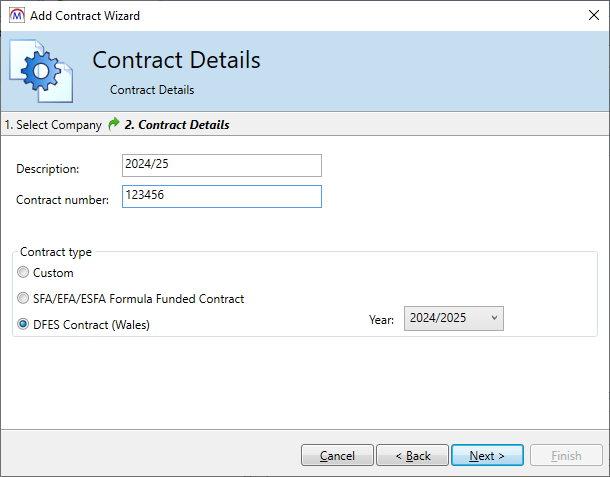
- Enter a contract description (e.g. DfES 2024/25).
- Enter a contract number if required.
- Select the DfES Contract (Wales) option.
- Select year 2024/2025.
- Click Next.
- Select the schemes you wish to include in the contract and click Next.
- Click Finish.
The Contract Wizard will create the appropriate funding model within Maytas and set up all the schemes that apply.
Maytas 5 Version 5.28.9010.1 Release Notes
2024/25 Contract Year Updates
New Maytas tabs for 2024/25 have been produced for the ILR and LLWR as per specifications from the Data Service and DfE. These will have been imported automatically in the upgrade. Please note that while both ILR and LLWR tabs are imported, the relevant tabs will only show for the relevant learners – i.e. ILR tabs will only show to learners on English schemes and LLWR tabs will only show to learners on Welsh schemes. Details of the tabs can be found below.
Please note that user permissions will need to be set for the new tabs, as by default they are available to all users. Also please note that if you have changed the field type for any ILR fields (e.g. to or from a lookup), these will need to be changed from the default field type in the screen designer.
LLWR Report for 2024/25
The 2024/25 Maytas 5 LLWR report has been produced based on a previous official form. Additional information not present on the official form has been included, such as employer and suspension data.
The LLWR report is automatically imported in the upgrade and can be found in the LLWR folder of the Reports Library.
There are two ways to run the report:
- On the Home tab, select Report Library | LLWR | LLWR 2024-25. This will let you search for a learner and select the sections to show.
- In a learner record, click Process and select LLWR 2024/25 Form. This will open a PDF export of the report for the learner / POT. It will use the default of showing all sections.
LLWR Export 2024/25
Generate Export
The LLWR export for 2024/25 is available in Maytas. The front-end functionality is the same as in 2023/24.
To view the LLWR export screen for 2024/25:
- Click Exports on the toolbar.
- Click LLWR Export on the ribbon.
-
Click the
 button.
button.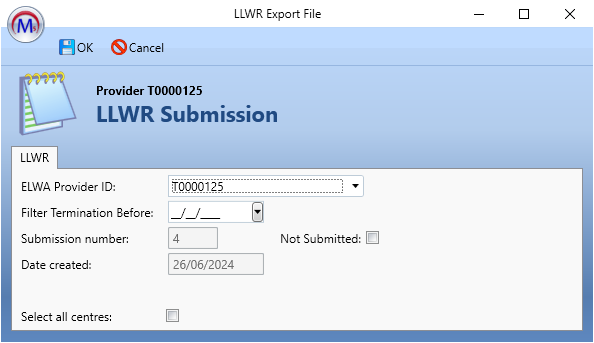
- Choose the ELWA Provider ID dropdown box.
- If you wish to only include learners who ended learning before a certain date, enter this date in the Filter Termination Before box.
-
Once ready, click OK.
-
Locate the submission by expanding the contract year and period using the arrows to the left. Click the submission to select it. The status will say GENERATE: Working on trainee… until the export data has been generated. It will then say Idle. Please note that this may take a while, depending on the amount of data being exported.

- Edit opens the export and allows you to view and edit the export settings. Please note that not all settings can be changed once an export has been created.
- Generate processes the export and produces a text file showing any errors for each learner. This allows you to correct any errors and re-generate before the batch file is created. The generation progress is shown with the circular progress bar to the right:
- View Log shows any errors in the export. These should be investigated and resolved and the data re-generated before outputting the XML.
- Output creates the actual batch file. The file will be created at C:\Temp on the Maytas server.
- Get File lets you download the batch file once it has been created.
LLWR XML Output
The LLWR export includes an option to create the submission file in XML format. This is much easier to read compared to the flat file, and it is also easier to locate information.
The ability to import the Overall Output file from the LLWR Data Collection site allows us to produce submission files consisting only of changes by default, as we can exclude records that have been accepted by the LLWR. At the beginning of each year a full file will be produced. Once the return Output file has been imported into the previous submission, only changes will be submitted.

The Output Changes XML link becomes active once the submission file has been generated. It will create an XML file on the server which can be retrieved by clicking Get File as normal. The file can be saved in XML format or as a zip file. The file can then be submitted to the Data Collection site. Please see the LLWR CSV User Tutorial from the Inform site for guidance on submission.
During the submission process, just after the Submit records to database step, you will have an opportunity to Download XML Output File (XML) from the Overview tab. It is important to do this as you will not get the option again after the Finalise Transaction process.
The XML Output file can be imported into Maytas on the submission by clicking Import XML Output File (this must be done on the same submission number that the export came from). This will indicate accepted records and provide error information. The Output file also contains ULI information which can be used to update the learner records in Maytas if required.
However, there are circumstances where the LLWR cannot provide the ULI at this stage, and consequently the ULI must be imported in the usual manner.
Once the XML Output file has been imported, subsequent XML files created will only include records that have not been accepted or where a change has occurred since the previous import. This can be overridden by ticking the Output Full XML checkbox near the top of the export screen.
TRAINEEPOT3 Table
A new table, TRAINEEPOT3, has been added to the database. This table is intended to be used for custom, user-added fields for POT-specific data.
New fields can be added to TRAINEEPOT3 using the Schema Editor (see here for instructions) and selecting TRAINEEPOT3 as the table name.
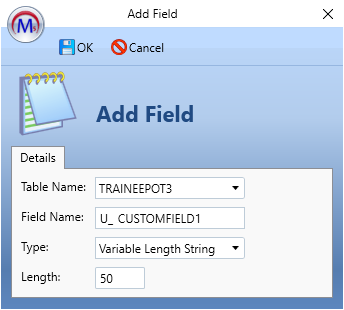
After performing a sync, the field will then be available across the system (e.g. in Report Generator, the Screen Designer, etc).
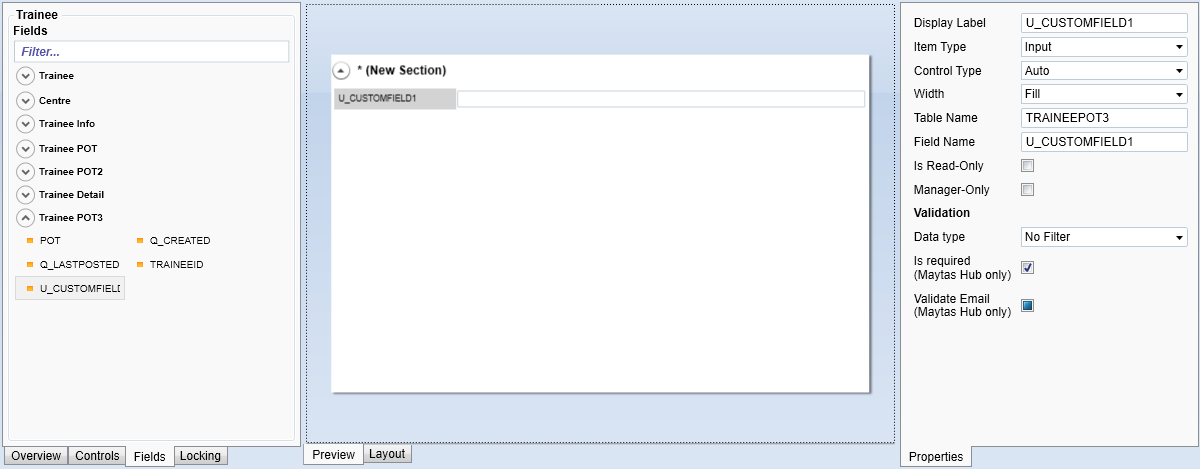
BKSB User Creation
Learners in Maytas can now be used to create a corresponding BKSB user. This requires the BKSB Integration module.
-
Open the learner record you wish to create a BKSB user for.
-
On the ribbon, select BKSB | Create user.
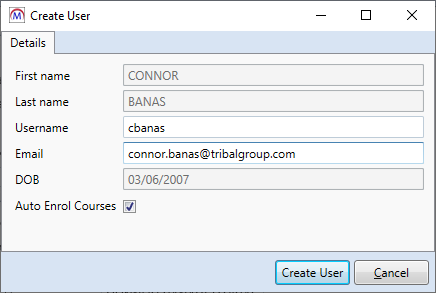
-
Review the data to be used to create the BKSB user. The username will default to the learner's web user account if they have one (or their BKSB username if they already have a user associated with them), but the username can be edited as required, as can the email address to use.
If the Auto Enrol Courses box is ticked, this will enrol the user on courses within BKSB.
-
Click Create User.
-
A confirmation message will appear when the user has been created in BKSB. Click OK.
Mandatory Option for File Select Control
The File Select control in the screen designer can now be set to be mandatory on application forms so that a file must be uploaded to successfully submit the form:
-
Go to Tools on the toolbar and click New / Load on the Screens panel of the ribbon.
-
Open the app form screen that you wish to edit.
-
Select the Controls tab at the bottom-left.
-
Drag a File Select control onto the design area (or select an existing File Select control on the screen).
-
Click the File Select control in the design area.
-
In the properties on the right, tick the Is required (Maytas Hub only) checkbox.
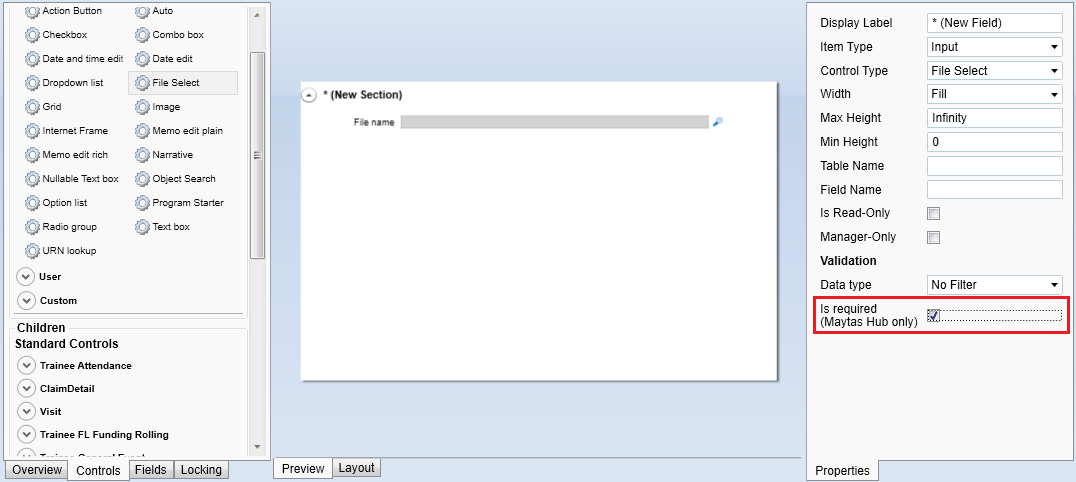
-
Click Apply.
-
Go to Home on the toolbar and click the Sync button.
Workflows - Latest Assessor / Employer of Specific Type
When invoking workflows that use the Default to latest assessor / employer option, you can now also choose to specify the assessor or employer type.
For example, if a learner has two active assessor records associated with them - an Assessor and a Tutor - selecting the type will tell the workflow whether to use the Assessor record or the Tutor record. If the type is not specified, the record with the most recent start date will be selected.
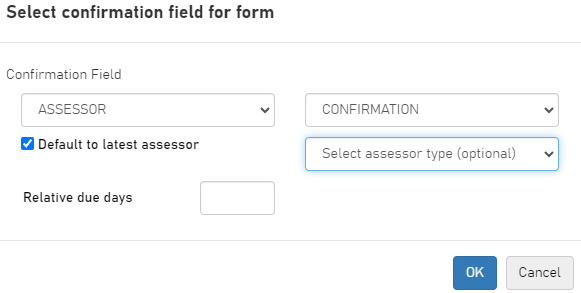
When the workflow is invoked in Maytas 5, the type that has been used is displayed in parentheses next to the assessor or employer.
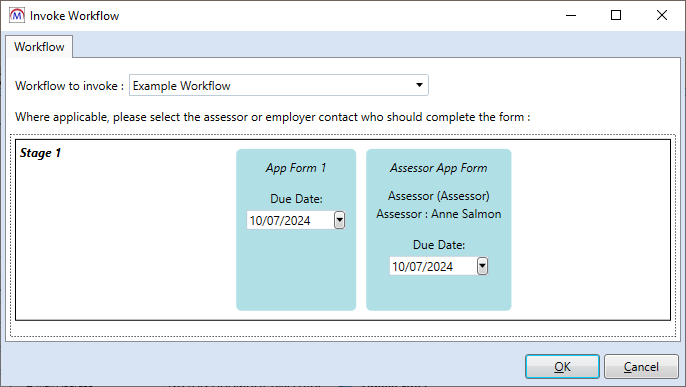
Reports Library 1.0.4.8
Upgrade the Reports Library
How to Upgrade the Reports Library
The Reports Library upgrade should be performed by an admin user, which will upgrade the reports for all users.
To enable to the Upgrade reports button for an admin user:
- Go to Tools | Edit Permissions.
- Select the user or group which requires permission.
- Go to the Commands tab.
- Expand the Support section.
- Set the Report SQL Upgrade permission to Visible.
- Click Apply and restart Maytas for the change to take effect.
For customers who manage their own systems on-premise, it is strongly advised to take a database backup before performing the upgrade. This is not necessary for hosted customers as backups are taken regularly.
To upgrade the Reports Library:
- Go to Support on the toolbar.
-
Click Upgrade reports.

- You will asked to confirm that you wish to perform the reports upgrade SQL. Click OK to continue.
- A message will appear saying that a task has been created. Click OK.
-
You can check that the upgrade was successful by going to Home on the toolbar and then selecting Server Tasks | View Jobs.

If the Status indicates that the upgrade has failed, please do not continue with importing the reports package and raise an incident on the Self Support Portal for assistance.
- Next, the reports package must be imported. Go to Home on the toolbar and click Import on the Reports panel on the ribbon.
- This will display the Report Import wizard. Click +Add Files.
- Browse to the Maytas 5\Extras\Reports Library folder of the upgrade, select one of the following packages and click Open:
- For all reports, select Reports Library 1.0.4.8 (all reports).
- For ESFA and general reports only, select Reports Library 1.0.4.8 (DfES and general reports).m5rep.
- Click Finish to import the reports. This process may take a long time (potentially upwards of 30 minutes) depending on the size of the reports package.
-
When the reports have finished importing, click Finish.
The import log may display various warning messages, which are generally a result of report formatting and other factors which do not impact how a report runs (e.g. The text box ‘textbox3’ extends beyond the bottom edge of its container.). Unless a message indicates that the import has failed, these warnings can safely be ignored.
Updates for 2024/25
The reports library has been updated to use fields from 2024/25 where appropriate and to include the 2024/25 report year on certain parameters.